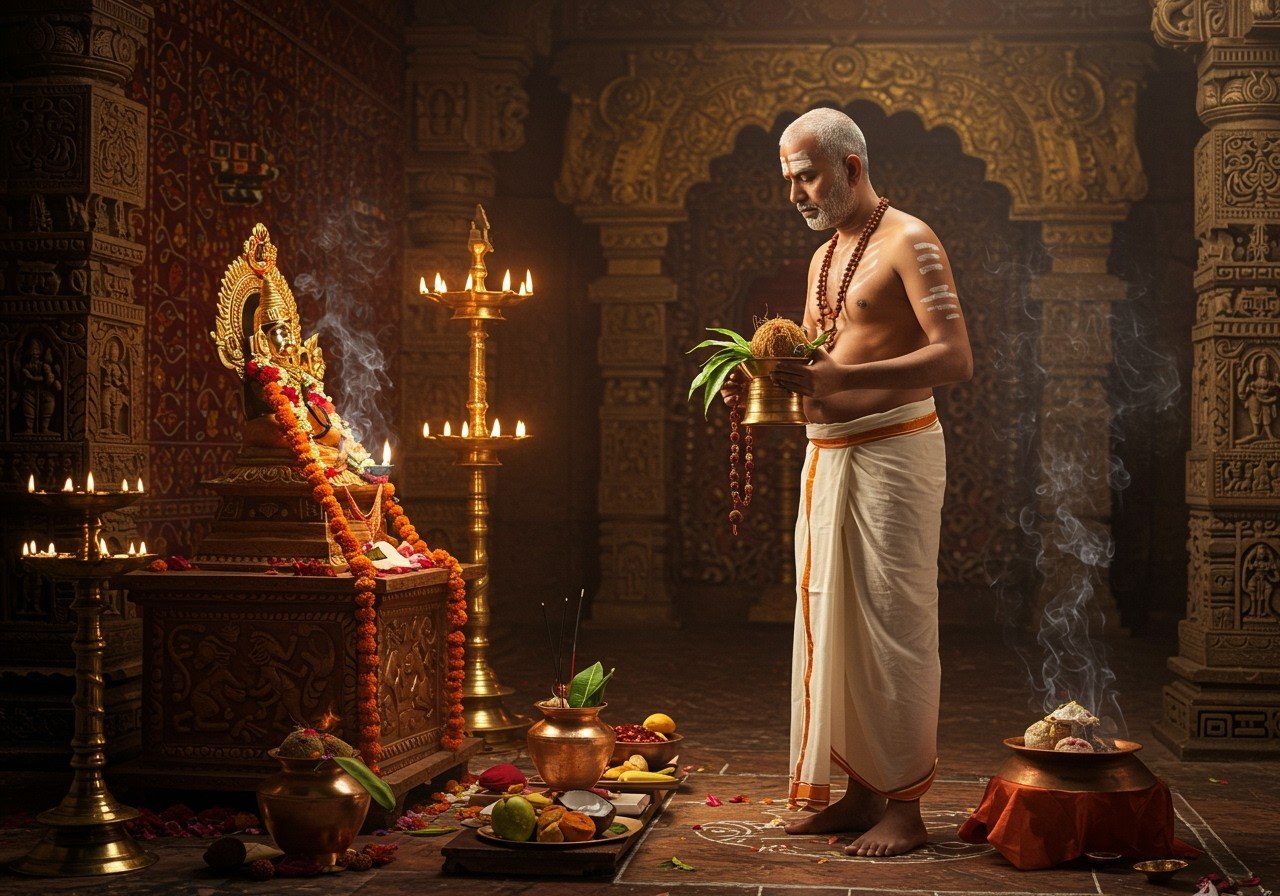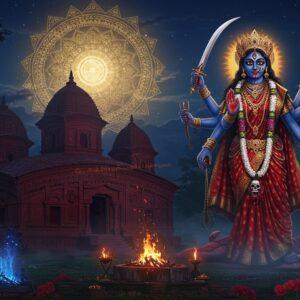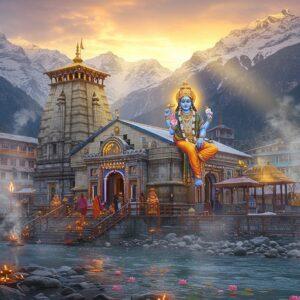
Stepping into the world of Pujari attire is like opening a window into the rich tapestry of Hindu rituals and traditions. The distinct clothing worn by Pujaris, our revered Hindu priests, holds profound meaning, especially during sacred ceremonies. These garments are not merely clothes; they are powerful symbols of purity, devotion, and an unbroken chain of tradition, reinforcing the priest’s vital role as a link between the divine and the devotees.
The Dhoti: A Symbol of Purity and Tradition
The dhoti takes center stage as a cornerstone of traditional Pujari attire. This unstitched length of cloth, typically seen in pristine white or auspicious saffron, is gracefully wrapped around the waist and legs. Its very simplicity speaks volumes, representing purity and humility, qualities deeply aligned with the priest’s sacred duties. The art of wearing a dhoti is a ritual in itself, passed down through generations, requiring both skill and reverence. The dhoti’s length and the way it’s draped can vary regionally, adding another layer of cultural richness to this timeless garment.
Different materials, from breathable cotton to luxurious silk, are chosen for dhotis based on the climate and the specific ceremony. You can find a wide variety of traditional dhotis suitable for different pujas at Poojn.in. The regional variations in dhoti styles beautifully reflect the diverse cultural landscape of Hinduism, with each style uniquely representing local traditions while upholding the garment’s sacred significance.
The Kurta: Grace and Modesty in Pujari Attire
Complementing the dhoti is the kurta, a long, shirt-like garment that adds a touch of grace and modesty to the Pujari’s ensemble. Typically loose-fitting and with long sleeves, it allows for ease of movement during rituals. Often, subtle embroidery or elegant embellishments adorn the kurta, enhancing its aesthetic appeal without overshadowing its spiritual significance.
Kurtas are crafted from comfortable, breathable materials like cotton or linen, ensuring the priest’s comfort during long ceremonies. The colors chosen for kurtas also hold symbolic meaning, often corresponding to specific deities or festival themes. Regional variations abound, with some kurtas featuring Nehru collars or intricate button detailing, a testament to personal or regional preferences. Maintaining the kurta’s pristine condition is essential, a mark of respect for the sanctity of the rituals.
Beyond the Basics: Accessories that Enhance Spiritual Significance
Pujari attire extends beyond the dhoti and kurta, incorporating various accessories that further enrich their spiritual significance. The yajnopavita, a sacred thread worn across the chest, is a powerful symbol of spiritual authority and lifelong dedication, bestowed upon the priest during a special ceremony. The angavastram, a cloth draped over the shoulders, adds another layer of reverence, particularly during prayers.
Headgear, such as turbans, plays a significant role, often denoting the priest’s lineage and the specific deities they worship. Different sects may have their own unique headpieces, reflecting the nuances within Hindu traditions. Rudraksha beads or malas, worn around the neck, symbolize spiritual focus and connection to the divine. Footwear is typically minimal, a gesture of humility and respect within the sacred space. The application of tilak or sandalwood paste on the forehead serves as a visible mark of devotion. Each accessory, carefully chosen and worn with reverence, enhances the ritualistic significance of the Pujari’s attire.
A Tapestry of Traditions: Regional and Cultural Variations
The beauty of Pujari attire lies in its adaptability and reflection of local customs across India. The climate plays a key role in material choices, with lighter fabrics preferred in warmer regions. Regional styles, like the distinctive Bengali dhoti or the elegant South Indian angavastram, showcase the rich diversity of Hindu traditions. Different sects, such as Vaishnavism and Shaivism, also have their own unique attire preferences, adding another layer of complexity to this fascinating aspect of Hindu culture.
Centuries of historical and cultural exchange have shaped the evolution of Pujari attire. Today, modern adaptations strive to strike a balance between honoring tradition and accommodating contemporary needs, ensuring that these sacred garments remain relevant and accessible to future generations. Family and community traditions also exert a strong influence on Pujari attire choices, adding depth and richness to every ceremony.
Navigating Modern Challenges: Preserving Tradition in a Changing World
In today’s rapidly changing world, Pujaris face new challenges in maintaining traditional dress amidst the pressures of urbanization and modern life. Thankfully, online platforms like Poojn.in offer a valuable bridge, providing easy access to authentic clothing and accessories, making it easier for priests to uphold these time-honored traditions.
Modern conveniences, such as pre-stitched dhotis and easy-care fabrics, have made traditional attire more accessible without compromising its spiritual significance. However, educating younger generations about the cultural and spiritual importance of these garments remains crucial for ensuring the continuity of these traditions. Festivals and special occasions often provide a renewed focus on traditional attire, even among urban Pujaris, reminding us of the enduring power of our cultural heritage. It’s paramount that we approach Pujari attire with respect and avoid cultural appropriation, honoring the sacredness of these garments while appreciating their beauty and symbolism. For a wide selection of puja items, visit Poojn.in’s puja samagri section.
Poojn.in: Your Partner in Preserving Tradition
Poojn.in is proud to offer a comprehensive selection of authentic Pujari clothing and accessories, meticulously curated to meet the specific requirements of various religious ceremonies. Here’s a glimpse of what awaits you:
Traditional Dhoti Selection:
- Pure cotton white dhotis ideal for puja and temple wear, ensuring purity and comfort.
- Premium quality fabrics sourced with utmost care, reflecting the sanctity of the occasion. Discover our premium cotton dhotis here.
Bengali Ceremonial Wear:
- Traditional Topor-Mukut sets, handcrafted with exquisite Shola work, perfect for Bengali weddings and other sacred ceremonies.
- Complete sets for both bride and groom, ensuring a harmonious and culturally rich celebration.
Essential Puja Clothing and Accessories:
- Pure cotton gamcha (traditional towel) for use during pujas and rituals.
Explore our collection of puja cloths. - Kora sarees and other white ceremonial clothing perfect for arpan and other religious occasions. Find a range of options for all your puja needs at Poojn.in.
To make your purchases:
- Visit our website: www.poojn.in
- Call us at: 03369029784
- Connect with us on WhatsApp: 9476142738
All our products come with a guarantee of quality and are thoughtfully selected to adhere to traditional requirements. Poojn.in offers pan-India delivery with secure packaging, ensuring the sanctity of these religious items is maintained throughout their journey to you. [Note: Prices may vary. Please check the website for current rates and availability]
Embracing Tradition with Modern Convenience
In our ever-evolving world, Pujari attire stands as a timeless testament to the richness and depth of our traditions. The dhoti, kurta, and sacred accessories are far more than mere garments; they are powerful symbols of devotion, respect, and a cultural heritage that has been cherished and passed down through generations. By understanding and embracing these elements, we honor the wisdom of the past while navigating the realities of the present.
Online platforms like Poojn.in have made it easier than ever to access authentic Pujari attire, allowing us to maintain our traditions with both convenience and reverence. Whether it’s for a grand festival, an intimate family ritual, or the quiet sanctity of daily worship, wearing traditional attire provides a tangible connection to our roots, keeping the flame of our culture burning brightly.
As we strive to balance modern life with the enduring values of our traditions, let us remember the profound importance of passing on this heritage to future generations. By doing so, we ensure that the beauty, significance, and spiritual power of Pujari attire continue to flourish, weaving a vibrant thread that connects yesterday, today, and tomorrow.
Frequently Asked Questions about Pujari Attire
What constitutes traditional Pujari dress? Traditional Pujari dress typically consists of a dhoti and a kurta, worn during religious rituals and ceremonies. Sometimes a namavali can also be part of the attire. Regional variations exist, and additional accessories like the angavastram and headgear add to the overall significance.
What is the symbolism behind the dhoti for Pujaris? The dhoti is deeply symbolic, representing purity, humility, and detachment from material possessions. It aligns with the spiritual nature of the Pujari’s duties. The way the dhoti is worn can differ regionally, reflecting the diverse cultural tapestry of India.
Is there a specific dress code for women Pujaris? Women Pujaris generally wear sarees, another traditional garment deeply respected in religious contexts. The saree, like the dhoti, signifies purity and reverence, upholding the dignity of the rituals. The color and style of the saree can vary depending on the specific ceremony or regional customs. You can find appropriate sarees for religious ceremonies on Poojn.in.
What types of materials are commonly used for Pujari attire? Cotton and silk are the most common materials for Pujari attire, chosen for their breathability, comfort, and suitability for various climates. Linen is another popular choice, especially for kurtas, as it provides comfort during long ceremonies. The quality of the material is an important consideration, reflecting the respect for the rituals.
Are there color preferences for Pujari dress? While white is the most prevalent color, symbolizing purity and peace, other colors hold significance as well. Saffron, representing spirituality and renunciation, is often seen. During temple rituals, Pujaris may also wear colorful shawls and garments, with colors varying based on the liturgical season and specific deities being worshipped.
Where can one purchase authentic dhotis and other items for Pujari attire? Traditional garment stores specializing in religious wear are a good starting point. Increasingly, online platforms like Poojn.in offer a convenient and reliable source for authentic Pujari attire. This allows for wider access, especially for those who may not have local access to specialized stores.
Have there been any modern adaptations to traditional Pujari attire? While traditional styles remain the cornerstone, some modern adaptations have emerged, primarily focusing on convenience and accessibility. Pre-stitched dhotis, for instance, offer ease of wear while retaining the traditional look. Similarly, modern fabrics may offer easier care while upholding the dignity of the attire. These adaptations cater to the needs of modern life while preserving the essence of tradition.


